September 1954
Editor: Whitney Ellsworth
Cover: Win Mortimer (Pencils and Inks)
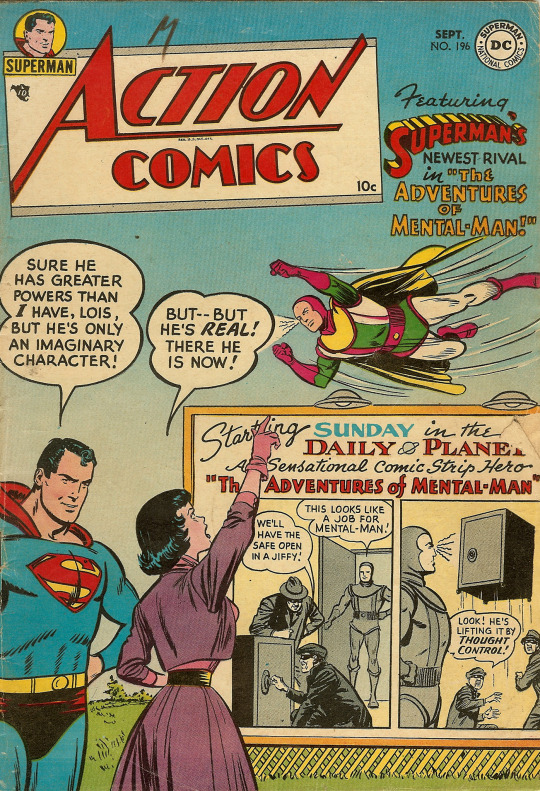
1. The Adventures of Mental Man!
Script: Bill Finger
Pencils: Wayne Boring
Inks: Stan Kaye
A new comic strip runs in the Daily Planet featuring Mental-Man, a superhero who uses his mind-over-matter powers to fight crime. The new strip is so popular no one notices Superman anymore.

Strangely, a cartoonist named “Inky” who is part of a criminal gang, claims he can tell that Mental-Man is traced from photographs and not drawn freehand. This leads the crooks to conclude that Mental-Man is real. This all seems very farfetched but somehow Superman knew this is exactly what would happen.
It’s all part of an elaborate plot he’s concocted with the aid of an artist at the newspaper and editor Perry White in order to catch the head of an international gold racket. Defying all logic, the plan works and the Mental-Man comic is retired. This is all fine with Lois Lane as she wasn’t a fan anyway.
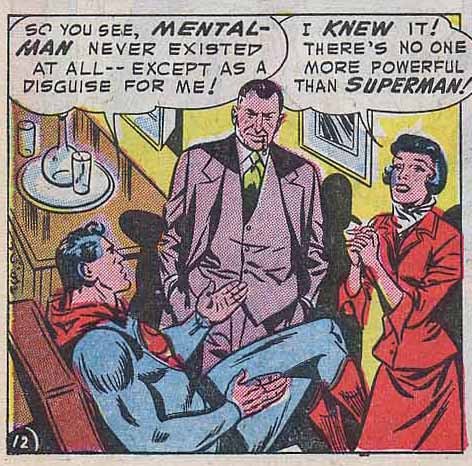
2. The Jungle Circus!
Script: Unknown
Pencils: Ed Smalle
Inks: Ed Smalle
Congo Bill’s long-running adventure series debuted in 1940, detailing his escapades in the jungles of Africa. He was popular enough that Columbia Pictures released a 15-chapter Congo Bill film serial in 1948.
In spite of this, his comic series was never a huge success, running consistently as a secondary feature in the back of comics headlined by bigger names. Early in 1954 Congo Bill acquired a sidekick, Janu the Jungle Boy and shortly after that, his own comic that lasted for only 7 issues (drawn by future Aquaman artist Nick Cardy).
Even while starring in his own title, Congo Bill didn’t lose his spot in Action Comics—making him one of those few characters at the time, besides Batman and Superman, to have stories published more than once a month.
This time, Janu is asked to join a circus traveling around Africa because of his talent with animals. Congo Bill forbids this and is shocked when Janu defies him and runs away.

This banquet is more important than going after Janu? Maybe Bill needs to have a talk with Bruce Wayne about raising a youthful ward.
As the the circus travels, they stop at a new village called Zumbasi. The night they arrive someone releases all the animals and the town is evacuated. Janu discovers the circus owner is really a diamond thief in disguise and it was his plan to empty the village because it was built on the spot he buried some loot.
Before the criminal can shoot Janu, Congo Bill shows up.
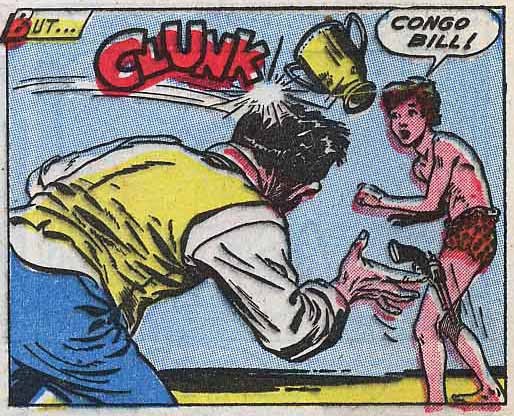
Now where have I seen that thing Congo Bill threw at the bad guy’s head?
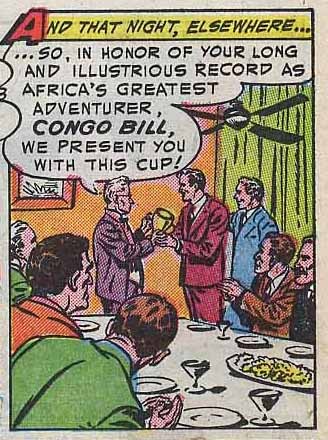
Oh that’s right, Bill received it at that super-important banquet he attended a few nights before. Apparently that cup was so important, he’d been carrying it around for days—never putting it down, as he searched the jungle for Janu. Luckily, it was in his hands when he found Janu in danger or who knows what might have happened.
It turns out, Janu recognized the diamond thief from the beginning, and only joined the circus to track down the hidden jewels. So why didn’t he tell Bill about his plan? Because he didn’t want Bill to miss the banquet!
3. The World Series of Tomorrow!
Script: Unknown
Penicls: Jim Mooney
Inks: Jim Mooney
Tommy Tomorrow was a science fiction series that ran from 1947-1962, mostly in the back of Action Comics and World’s Finest. In 1962 and 1963, a revamped version appeared in 5 issues of Showcase, as a tryout for his own title but nothing ever came of it. In fact, he was dropped completely from publication after that.
Tommy Tomorrow, colonel of the Planeteers, travels through space in the 21st century wearing purple shorts—which must be one of the most ludicrous uniforms of all time. When he comes across some martians playing a dangerous sport, he suggests they learn the safe, wholesome, Earth sport of baseball.
Before long, Tommy Tomorrow has gotten the inhabitants of all the planets in the solar system to give up their dangerous sports (like polo?) in favor of baseball. (Doesn’t Tommy look tough in his purple shorts with his legs crossed?)

An interplanetary league is formed, but when gamblers try to fix games, Tommy must go after them. And on top of everything else, he’s chosen to be the umpire for the Solar System Series.
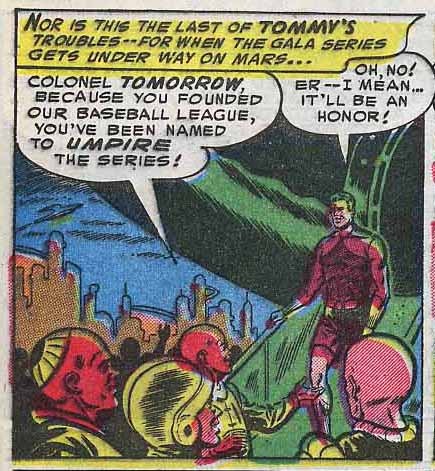
The criminals kidnap the entire team from Venus and replace them with robots to make sure Mars wins but Tommy figures out what’s going on. The gang is apprehended and he must escort them to jail on earth—which means he get’s out of umpire duty.
4. Vigilante – Foreign Correspondent!
Script: Unknown
Penicls: Howard Sherman
Inks: Howard Sherman
Vigilante—a costumed hero who dressed like a cowboy and rode a motorcycle—was launched in 1941 but this was his next to last appearance before disappearing for a couple of decades. His teenage sidekick, Stuff, the Chinatown Kid, was also the assistant to his secret identity, country singer Greg Sanders. When Stuff went into action with Vigilante he didn’t change his name or appearance so it’s astonishing no one ever figured out who Vigilante really was.
Here we find Greg Sanders on a singing tour of Europe. One night, an American freelance correspondent is shot outside Greg’s Paris hotel room. Before losing consciousness, he mentions a portable radio and Vigilante and Stuff try to pick the trail of the reporter’s investigation.
This leads them to a tulip export company in Rotterdam where they run into a shipping clerk named Darrow. Searching the company’s offices after hours, they discover someone is smuggling diamonds inside hollowed out tulip bulbs. Suddenly the phone rings.
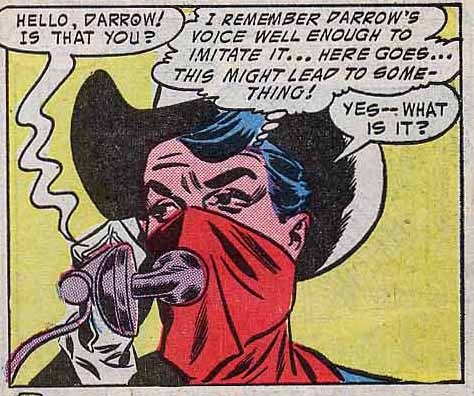
Turns out Greg is not only a singer but a mimic too!
Using the information he learns from the caller, he’s able to track down the mysterious radio and discover the incriminating recording hidden within. Darrow and his smuggling ring are defeated—and Vigilante writes up the whole story and turns it into the foreign correspondent recovering in the hospital. Singer, mimic, reporter”¦ is there anything Vigilante can’t do?
I had never heard of Howard Sherman before, the artist for this story, although he worked for DC Comics for nearly 25 years. He drew all kinds of stories during that time but his most high-profile work was probably a long-running stint on the magical superhero Dr. Fate.
He also drew a lot of westerns which might be why his work on Vigilante was so good. I particularly liked this panel from today’s story.

There’s just enough detail to convey a mood, and the necessary information, without getting too busy. His drawings sometimes remind me of artist George Papp, a good friend of Sherman’s, who worked on Superboy and Green Arrow.